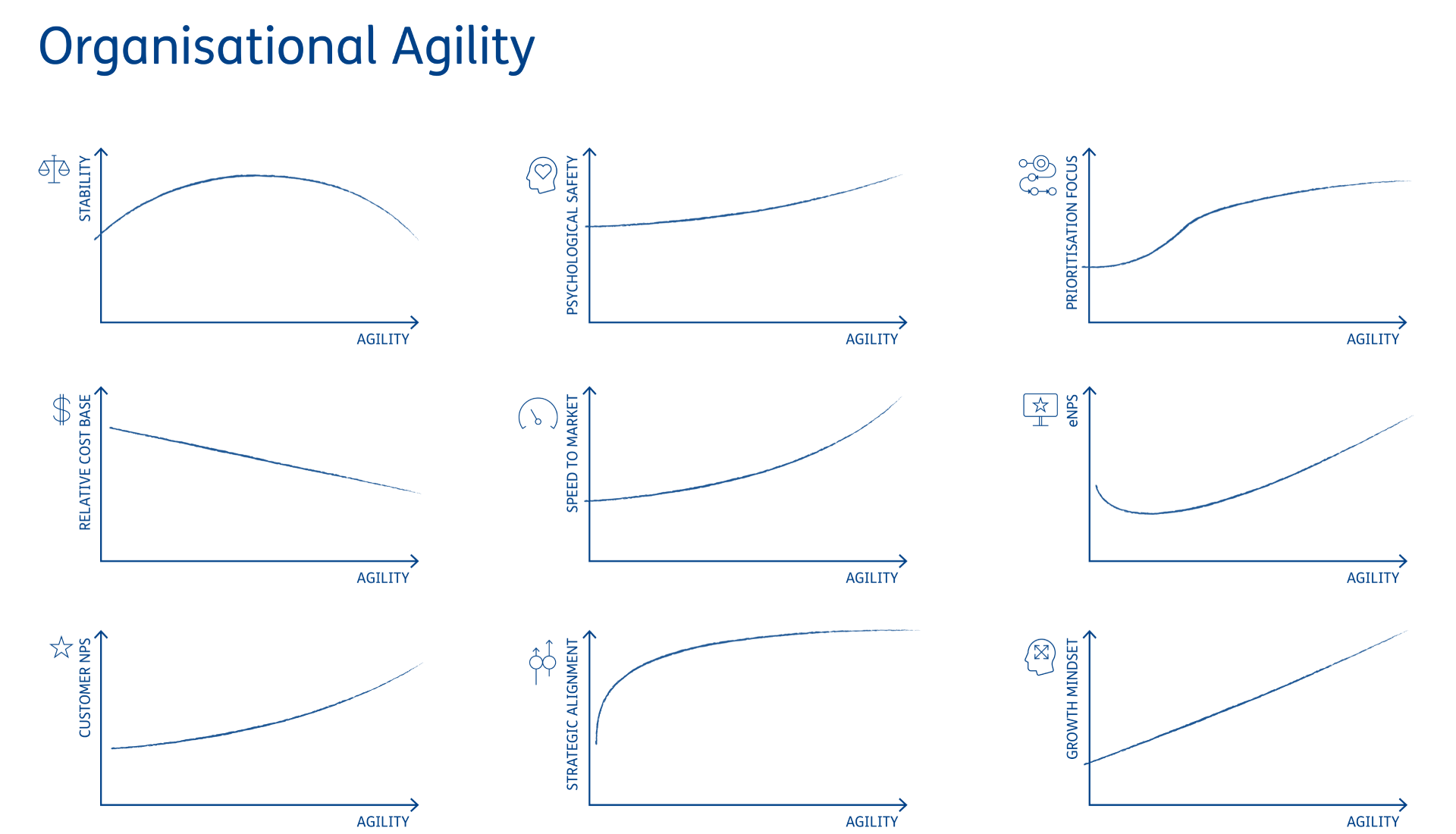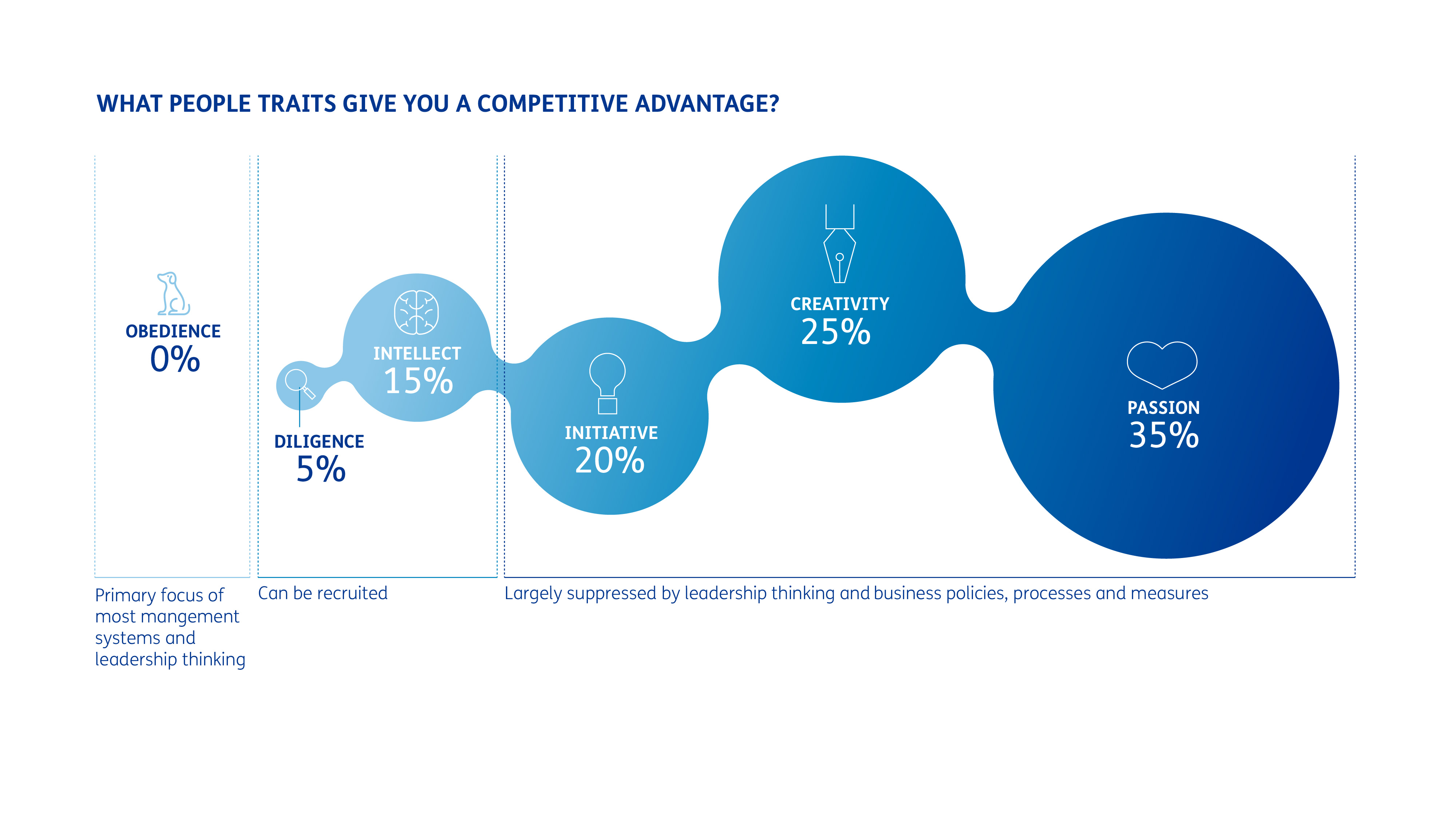
The agility paradox
4 October 2021
Moving from frozen to fluid: how leaders can foster organisational agility
75% of organisations have agility in their top three strategic priorities, but less than 5% have achieved enterprise-wide transformation. There is a recognised need for companies to be Agile, but many fail to translate this into a necessary organisational capability, namely agility.
Let’s start at the beginning. Consider the following… Have you ever really thought about the terms ‘leadership training’, ‘Agile projects’, and ‘building trust’?
- Often, leadership training focuses exclusively on management techniques.
- Conversely, those who truly appreciate the Agile manifesto don’t follow traditional approaches to project management.
- And while trust is critical to fostering a healthy organisational culture, hopefully we all agree that trust cannot be built… It must be earned.
Many concepts start as great ideas and improvement drivers, but over time, they get eroded – either by their users or by the turbulent environments around them. In recent times, the world of business has reached new levels of turbulence. Organisations today are facing a huge degree of volatility across three fronts:
- Consumer. The pandemic has clearly reshaped people’s needs, lifestyles and values. These changes have in turn altered their behaviours and spending patterns. The shift to digital is here to stay – even for population segments that have historically lagged behind. Product personalisation and market disruptors are affecting companies’ core value propositions. Meanwhile, always-on business models are changing the nature of work and the skills organisations need.
- Economic. Evolving consumer trends have significantly impacted the economy. Some industries are struggling, while others have seen huge surges in demand. Changes in fiscal and regulatory policy are increasingly unpredictable and can affect multiple parts of the business. This financial and market volatility is impacting organisations and their supply chains to a greater extent than ever before. Not to mention, climate risk and net zero are fast becoming the defining issue AND opportunity of this era.
- Talent. For the first time in history, we have five generations in the workforce. Gone are the days of people joining an organisation and staying for decades. Instead, millennials seek to gather a broad portfolio of experience, by switching between jobs and companies more frequently. It’s now normal to consider an organisations’ societal and environmental impact when choosing where to work. Furthermore, these changes are all occurring at a time when physical and mental health have never been higher on the global and local agenda.
Constant, extreme volatility across these fronts creates both challenges and opportunities for companies. It also makes it extremely difficult for executive teams to predict what’s around the corner.
Agile vs agility
Many executive teams look to Agile to help them respond to this volatility. But few realise that, simply put, Agile is too fragile. To achieve meaningful results, organisations need to reframe agility and see it as an organisational capability.
What does that mean in practice? We’ve seen a lot of companies ‘Agile-washing’. Teams are renamed as ‘tribes’ and people talk about ‘sprints’. But when you take a closer look, everything is the same as before. In many cases, the more companies talk about Agile, the less nimble they actually are.
To foster agility at the organisational level, leadership teams need to augment Agile methodology with broader changes to their operating model, roles, skills and ways of working. And that’s where the real challenges lie.
The C-Suite’s primary focus needs to be on organisational culture
Organisational agility doesn’t come overnight. Leaders must focus on creating the right culture so that agility can grow and thrive.
Many people talk about building the right culture, but what does that truly mean in this context? Baringa’s research shows us that this boils down to three key imperatives:
- Create slack. The obsession with being ‘Lean’ has driven companies to optimise and account for every moment of employees’ time. Counterintuitively, this purist approach clashes with agility. Leaders should ensure their people have enough unstructured time to inspire creativity and innovation. Whether it’s 3M, Google or Atlassian, the concept of ‘20% time’ is now a widely recognised technique to foster innovation and creativity. We have a concept in Baringa (driven by our Managing Partner, Adrian Bettridge) of embracing boredom… allowing our minds to wander, increasing our creativity, improving our mental health and driving breakthroughs.
- Measure what matters. It’s down to the executive team to set a clear strategic purpose for the organisation, and keep people focused on it. At Baringa, we talk about the concept of ‘tight/loose’. Instead of trying to control (be ‘tight’ on) everything, leaders should concentrate on the few key metrics that will have the greatest impact on their strategic purpose. This idea isn’t new, and many organisations focus on a ‘critical few’ KPIs. The challenge, from a cultural perspective, is for the C-Suite (and subsequently each level down) to be ‘loose’ on everything else. Given the background volatility that organisations face, this tight/loose framework needs continuous review and refinement, to ensure the ‘tight’ measures remain relevant.
- Foster psychological safety. This point is paramount. It simply cannot be overstated. Executive teams must make sure their people feel comfortable taking risks and experimenting with new ideas, knowing that they won’t be reprimanded if things don’t work out. Most innovations don’t succeed. So when people fail, managers must encourage them to learn from their mistakes and try again. Clarity and consistent communication around your organisation’s strategic narrative will help your teams align their creativity to a common vision.

These three imperatives fly in the face of many management approaches in place at organisations today. They require executive teams to unlearn past behaviours and shift their mindset. That can be a difficult adjustment.
Trust is paramount
The common theme running through this is trust. To put these three imperatives into action, leaders need to start placing greater trust in their employees. To illustrate this point, we’ll draw on insights from Rachel Botsman – trust fellow, author and lecturer at the University of Oxford's Saïd Business School.
Botsman defines trust as “a confident relationship with the unknown”. She says it’s not the same as transparency, because transparency assumes everything is ‘known’. In the context of organisational agility, this means leaders don’t need to know everything that’s going on, because they should trust employees to do the right thing, even when they’re not looking. In practice, this translates into decentralised decision-making.
Similarly, Botsman states that “the need to control comes from a lack of trust”. This ties back to the point we touched on earlier about leaders not needing to be ‘tight’ on everything.
At Baringa, we believe trust has to work both ways. Just as leaders need to trust their people, they also need to earn people’s trust. We apply this principle both internally and in our work with clients.
It’s surprising when organisations say they are going to build more trust. You can’t build trust… You have to earn it, and to do that, you have to demonstrate that you are trustworthy all the time. This relates to the imperative around fostering psychological safety. Executive teams need to prove they are trustworthy by consistently reacting well, ESPECIALLY when things don’t work out.
This idea is echoed in Jack Zenger and Joseph Folkman’s study of leaders who are trusted by their employees. Their research highlighted three behaviours that help executives earn trust:
- Building positive relationships with other people and groups. This includes staying in touch with others’ concerns, encouraging cooperation between others, and giving honest feedback in a helpful way.
- Exercising good judgement. Trusted leaders make sensible decisions, and use their knowledge and expertise to make an important contribution to organisational results.
- Demonstrating consistency. This is about having a transparent set of consistent principles, being a good role model and setting a good example.
To pair these behaviours with agility, executive teams need to tread a fine line…
- How can they stay in touch with others’ concerns without micro-managing?
- How can they make an important contribution without overshadowing their employees?
- How can they set a good example without getting bogged down in day-to-day operations?
This is a puzzle that still needs solving in most organisations today. If employees trust senior leaders, they’re more likely to follow and support them as they innovate and transform the business. Common alignment in your organisation’s strategic vision is everything. Trust and strategic alignment are proportional – so the greater the trust, the less effort is spent on communicating, convincing and corralling. This means more time can be dedicated to outcome-focused transformation and delivering value for the customer.
The impact of agility
When an organisation has the right trust-based culture in place, agility becomes a multiplier of business performance. The commonly used equation changes from…


Agility impacts every aspect of an organisation. It helps companies reduce costs, accelerate speed-to-market, boost their customer and employee net promoter scores (NPS and eNPS), and much more.

Agility also enables the mindset of continuous improvement across an organisation. To make this happen, executive teams need to shift their focus away from traditional ‘employee engagement’ and move toward a focus on ‘employee passion’. There’s a key difference here. Engaged employees are happy as they are, but passionate employees are always striving for more. The sweet spot for agility is having passionate employees exploring new ways to reach organisational goals.

Debunking agile myths
Let’s be honest, a lot of businesses (and not to mention, a lot of consultancies) are talking about Agile and agility, but each one has a different approach to implementation. To get off to the right start, executive teams must be aware of common myths and recognise some important truths.
- You can’t just run fast with zero planning. We’ve seen many organisations try this. It never works. Yes, in an agile organisation, the plans may look different, but planning is just as important. The key is to start small, think big, and go fast. Leadership teams should adopt a mantra of ‘start less, finish more’.
- Outcome-based objective setting. The Agile manifesto was originally written to guide developers as they build and enhance technologies. In that environment, people are clear on what they are looking to achieve when they rapidly experiment, fail fast, and perform quick, successive launches of new features/functionality. Outside that context, things are less clear-cut, and people need more direction. This means leadership must provide clear objectives and key results (OKRs) before they set their teams to work. This shifts an organisation’s lexicon to an outcome-based language. This linguistic shift can be challenging, but, once achieved, the pace of real change accelerates exponentially.
- Stability is not the enemy. It sounds counterintuitive, but to foster agility, organisations do need a degree of stability. However, that stability can take many different forms. It might be long-serving members of the leadership team, or self-forming communities within a business spanning multiple organisational levels. Alternatively, it could be a thin governance framework, or a regular sprint cadence. These small elements of stability act as an axis around which the rest of the organisation can gravitate. If everything changes at once, without a stable centre of gravity, all you achieve is chaos. So, in short, agility requires stability.
What have we learned? Organisational agility isn’t easy to develop, and it won’t materialise overnight. Executive teams require real courage, and a willingness to change their own behaviours as well as their organisations. A fluid organisation combined with a high-trust culture has been proven to deliver a wide range of results, without trade-offs.
Organisations with a high degree of agility can achieve greater speed, higher quality and lower costs in parallel. The evidence is strong across all sectors. Baringa’s research and our client delivery results show that organisational agility, deployed well, can provide on average:
- 50% increase in speed-to-market
- 30% increase in employee engagement
- 35% decrease in cost of change
- 50% improvement in quality
Organisations that are engaged and can transform in a fluid way hold the key to short and long-term success. Agility provides the DNA, with the right leadership culture helping engrain in into the organisation.
Rather than seeing transformation, change, operational excellence and agility as separate capabilities and teams, we encourage our clients to bring these underlying skillsets together. Many organisations will hire new people, without realising that much of the combined skillset already exists within their organisations. By upskilling and repurposing their existing talent pool, organisations can achieve faster and more sustainable transformations.
Facing into these challenges as early as possible widens the gates of opportunity for an organisation. Equally, as executive teams look to respond to the constant volatility around them, one thing is clear – for those that do take the leap toward agility, the shift is transformational and the benefits are vast.
If you think we can help you solve the agility paradox at your organisation, contact us today.
Our Experts


Developing Organisational Agility
We’ve been working with leaders in enterprise organisations to transform their companies and harness the power and ingenuity of all their people to deliver great outcomes for their customers. We’re helping them embed the organisational structures, mind-sets and behaviours that enable the business to work at pace, while remaining in control. And we’re helping them form the fundamental building blocks that allow them to adapt to future challenges.
Related Insights

Organisational agility: a guide to taking the first steps
Our business agility and operational excellence expert Simon Tarbett offers some advice to clients when asked the question, Where To Start?
Read more
The need for agility to grow revenue and thrive in a turbulent market
We’re looking at how organisations need to be agile if they’re to grow revenue and thrive in a turbulent market.
Read more
How to set targets to drive business performance
Targets are essential for driving better business results. Let’s discuss what companies should – and shouldn’t – be doing.
Read more
How frozen organisations can become fluid
To develop organisational agility, focus on being like water.
Read moreIs digital and AI delivering what your business needs?
Digital and AI can solve your toughest challenges and elevate your business performance. But success isn’t always straightforward. Where can you unlock opportunity? And what does it take to set the foundation for lasting success?